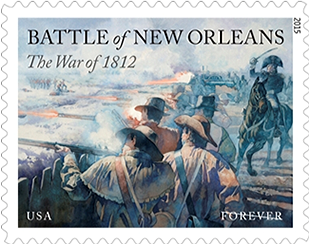Engraving of the Battle of New Orleans by Henry Bryan Hall courtesy https://research.archives.gov/id/531091.
The War of 1812 was fought between Britain and the United States from 1812 to 1814, much of which was fought around the Great Lakes. However, the Battle of New Orleans took place in early 1815, the reason being that word had not yet reached the Deep South that the Treaty of Ghent had been signed on Christmas Eve 1814.
A British fleet under the command of Sir Alexander Cochrane, had anchored in the Gulf of Mexico tot he east of Lake Pontchartrain. The British, with a force of 11,000 men took on the Americans, under the command of General Andrew Jackson, a force of only 4,732. The Americans, however, suffered only 62 casualties and losses as opposed to Britain's total of 2,034.
The victory, considered by French Quarter residents, was attributed to divine intervention. The night before the battle, Ursuline nuns, along with New Orleans' faithful, gathered at the Ursuline Convent and prayed in front of the Virgin Mary statue for the American troops. The next morning, as the Vical General conducted mass at the same chapel, a courier interrupted with the news that the British had been defeated. General Jackson, personally paid the nuns a visit after the battle to say thank you: "By the blessing of heaven, directing the valor of the troops under my command, one of the most brilliant victories in the annals of war was obtained." Fourteen years later, Jackson became the seventh President of the United States.

U.S. Stamp issued on the 200th Anniversary of the Battle of New Orleans courtesy http://about.usps.com/news/national-releases/2015/pr15_003.htm.

No comments:
Post a Comment